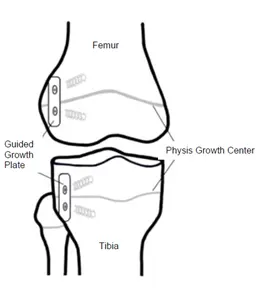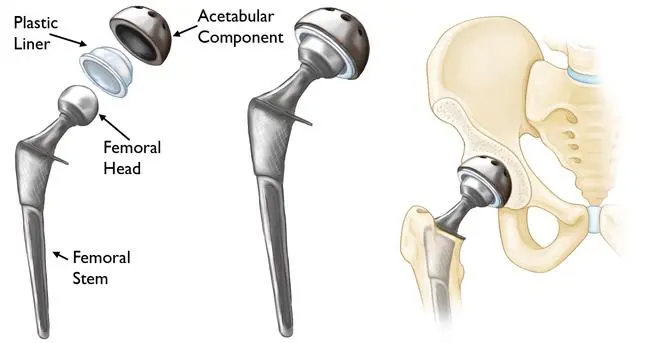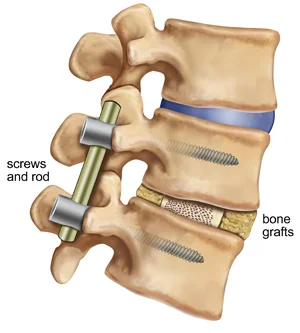Spinal Fusion Surgery
Spinal fusion surgery is a surgical procedure used to permanently connect two or more vertebrae in the spine. The goal of spinal fusion is to eliminate motion between the vertebrae and stabilize the spine.
What is Spinal Fusion Surgery?
Through a surgical process known as spinal fusion, two or more vertebrae are permanently fused together to form a single, solid bone with no gap between them Spinal Fusion Surgery.
The spine’s tiny, interconnecting bones are called vertebrae. Extra bone is utilized in spinal fusion to cover the gap that typically exists between the two distinct vertebrae. There is no longer any gap between them when the bone heals.
Spinal fusion, often referred to as spondylodesis or spondylosyndesis, is a procedure in which two or more vertebrae are joined by orthopedic or neurosurgeons. Any level of the spine, including the cervical, thoracic, lumbar, and sacral regions, can undergo this operation, which stops the fused vertebrae from moving.
There are several forms of spinal fusion, and all of them entail the use of bone grafting to promote the healing of the patient’s own bones (autograft), donor bone (allograft), or synthetic bone replacements Spinal Fusion Surgery.
While the graft fused the two vertebrae together, additional hardware such as cages, screws, or plates is frequently utilized to keep the bones in place. Hardware placement can be guided by robots, navigation systems, or fluoroscopy.
The most common reason for spinal fusion is to alleviate pressure and discomfort on the spinal cord or vertebrae caused by mechanical pain from a worn-out disc, which is the cartilage that sits between two vertebrae Spinal Fusion Surgery.
In the event that the patient’s anatomy makes disc replacement impossible, it is also utilized as a fallback technique for intervertebral disc arthroplasty, a surgery that replaces the whole disc.
In addition to spinal stenosis, spinal fusion is frequently used to treat spondylolisthesis, spondylosis, spinal fractures, kyphosis, and scoliosis. Complications from surgery might include infection, hemorrhage, and nerve injury.
Additionally, fusion alters the spine’s natural mobility and increases the strain on the vertebrae that are above and below the joined segments. Degeneration at these nearby spine segments is thus one of the long-term consequences.
Other Names For Spinal Fusion Surgery:
- arthrodesis
- fusions of the anterior spine
- Fusion of the posterior spinal column
- interbody fusions of the vertebrae
Uses Of Spinal Fusion Surgery
Many spinal disorders are treated or their symptoms are relieved by spinal fusions. Mobility between the two treated vertebrae is eliminated during the treatment.
Although it could reduce flexibility, this is helpful in treating spinal issues that cause discomfort when moving.
Among these illnesses are:
- tumor
- cases of spinal stenosis
- disc herniations
- degenerative disc disease
- cracked vertebrae that might be causing instability in your spinal column
- scoliosis (spinal curvature)
- Kyphosis, or improper curvature of the upper back
- Weakness or instability of the spine brought on by severe infections, tumors, or arthritis
- spondylolisthesis is a painful condition where one vertebra slides onto the vertebra underneath it.
A discectomy might potentially be a part of a spinal fusion operation. A discectomy is a surgical procedure wherein a disc is removed because of injury or illness. To maintain the proper height between bones after the disc is removed, bone grafts are inserted into the empty disc area.
To create a bridge (or fusion) across the bone grafts and enhance long-term stability, your doctor will utilize the two vertebrae on either side of the resected disc.
Cervical fusion refers to the process of performing spinal fusion in the cervical spine in conjunction with a discectomy.
Discs or bone spurs are removed from the cervical spine, which is located in the neck, by the surgeon instead of a vertebra. Discs between the vertebrae of the cervical spine divide its seven vertebrae.
Preparing For Spinal Fusion Surgery
Preparation for spinal fusion usually resembles that of other surgical procedures. Preoperative laboratory testing is necessary.
You should disclose any of the following to your doctor before having a spinal fusion:
- smoking cigarettes, which might hinder your recovery after a spinal fusion
- alcohol consumption
- any ailments you may be experiencing, such as colds, the flu, or herpes
- whatever over-the-counter or prescription drugs you now use, including dietary supplements and herbal remedies
It’s important to talk to your doctor about how to take your medications both before and after the surgery. If you are taking any drugs that may interfere with blood coagulation, your doctor may give you specific advice.
These include nonsteroidal anti-inflammatory medicines (NSAIDs), such as aspirin and ibuprofen, and anticoagulants (blood thinners), like warfarin.
You must fast for a minimum of eight hours before your surgery since you will be administered general anesthesia. Take any prescribed drugs with a sip of water on the day of surgery, per your doctor’s advice.
How Is Spinal Fusion Performed?
In a hospital’s surgical department, spinal fusion procedures are carried out. You won’t be aware of or experience any discomfort because a general anesthetic is used throughout the treatment.
You will be lying down during the operation, with leads from a cardiac monitor on your chest and a blood pressure cuff on your arm. This enables your blood pressure and heart rate to be monitored by your anesthesiologist and surgeon while you are having surgery.
The entire process might need many hours. The bone transplant that will be utilized to join the two vertebrae will be ready by your surgeon.
Your surgeon will make an incision above the pelvic bone and remove a little portion if your own bone is being utilized. An allograft, bone from a bone bank, or a synthetic bone might potentially be used in the bone graft.
Your surgeon will create an incision to put the bone, depending on where it will be fused.In order to expose the cervical spine during a cervical fusion, your surgeon will often create a little incision in the frontal fold of your neck.
To unite the afflicted vertebrae, a bone graft will be inserted between them. In certain cases, specialized cages are used to put the graft material in between the vertebrae. Certain methods position the graft above the lumbar region.
Your surgeon may use rods, screws, and plates to stabilize the spine once the bone transplant is in place. We refer to this as internal fixation.
The additional rigidity that the rods, screws, and plates give promotes a faster and more successful healing process for the spine.
Recovery From Spinal Fusion
You will need to spend some time recovering and being observed in the hospital following your spinal fusion. Usually, this lasts for three or four days. Your doctor will first want to watch you to make sure you are responding to the anesthetic and the procedure.
Your physician’s protocols, your response to the procedure, and your general physical state will all affect when you can be released from the hospital. You will be given pain medicine while you are in the hospital.
You’ll also receive guidance on any new movements you might need to make because your range of motion might be restricted. To walk, sit, and stand securely, you might need to pick up some new skills.
Additionally, it can take you a few days to be able to resume your regular solid food diet. You might need to wear a brace after you leave the hospital in order to maintain the right alignment of your spine.
It may take some time for your body to integrate the bone into place before you can go back to your regular activities. It might take up to six weeks or more to fuse. To assist you learn safe movement techniques and improving your back, your doctor could advise physical therapy.
It will need three to six months to fully recover following spinal fusion. Your age, general health, and physical state all have an impact on how soon you recover and can resume your regular activities.
Complications Of Spinal Fusion
Like every operation, spinal fusion entails some risk of complications. These include:
- infection
- clots of blood
- Loss of blood and bleeding
- respiratory issues
- During surgery, a heart attack or stroke
- insufficient healing of wounds
- responses to drugs or anesthesia
Additionally, there is a chance of these uncommon side effects following spinal fusion:
- infection in the incision or spine that has been treated
- spinal nerve injury, which can result in pain, paralysis, and issues with the bowels or bladder
- more stresses on the nearby bones of the united vertebrae
- Persistent soreness at the bone transplant site
- potentially fatal blood clots in the legs that might go to the lungs
Blood clots and infection are the most dangerous side effects, and they usually manifest in the first few weeks after surgery. If the hardware is causing pain or discomfort, it must be taken out.
If you encounter any of the following signs of a blood clot, get in touch with your physician or call for emergency assistance:
- an unexpected enlargement of the foot, ankle, or calf
- Sensitivity or redness above or below the knee
- Leg Pain
- calf pain
- groin ache
- dyspnea
If you encounter any of the following infection signs, get in touch with your doctor or call for emergency assistance:
- redness or swelling around the wound’s perimeter
- The wound’s outflow of blood, pus, or other fluids
- chills, a fever, or a temperature increase to above 100 degrees
- trembling
Outlook For Spinal Fusion
For some back problems, spinal fusion is usually a successful therapy. It might take several months for the mending to occur. As you become stronger and more confident in your motions, your symptoms and comfort level will progressively get better.
You should have a general reduction in discomfort following the operation, even if it might not completely alleviate your chronic back pain.
However because the fusion immobilizes a section of the spine, it alters the structure of the spine and increases the likelihood of wear and tear in the areas above and below the fusion. If they get worse, they could hurt and you might have further issues.
Additionally, being overweight, sedentary, or in poor physical health might increase your chance of developing other spinal issues. You will get the finest results if you lead a healthy lifestyle that includes frequent exercise and dietary care.
What Happens After Spinal Fusion Surgery?
Most children spend a few days in the hospital following a fusion. This allows them more time to heal after their operation and become more mobile.
They’ll be able to move about and perform numerous daily tasks (including taking a shower, getting dressed, and climbing stairs) by the time they go home.
Children with really severe scoliosis or those with additional medical issues may require a lengthier hospital stay. The members of their care team will monitor them closely and manage any issues (including pneumonia, constipation, or difficulty eating).
Both prescription and over-the-counter (OTC) pain relievers, such as acetaminophen and ibuprofen, are used to alleviate pain following surgery.
Prescription pain relievers include narcotic painkillers. For less than two weeks, the majority of children who use prescription painkillers to treat pain and muscle spasms do so. In the first two weeks following surgery, children can taper off on the quantity of pain medication they need.
How Does Spinal Fusion Surgery Work?
Spinal instrumentation and bone grafts are used by the surgeon to support the curved portion of the spine during spinal fusion surgery.
- The metal rods, hooks, and screws that surgeons affix to the abnormally curved portion of the spine to support it in an upright posture are referred to as “instrumentation.”
- Small pieces of bone that the surgeon packs around the deformed vertebrae are called bone grafts. This promotes the healing of this spinal segment into a strong bone. This procedure is comparable to how a damaged bone would naturally mend. During surgery, the patient’s own bone may be used for the bone graft, or it may come from the hospital’s bone bank.
- Following spinal fusion surgery, recovery typically lasts six to twelve months. The aberrant portion of the spine will not bend further once the bones have united. Normally, the instrumentation stays in the spine without posing any issues.
FAQ
Is spinal fusion a serious surgery?
Surgery for spinal fusion is a dangerous medical operation. Before surgery, your doctor will probably advise you to try alternative therapies. This is because there may be other, better options available without surgery. However, this does not imply that spinal fusion surgery should be avoided.
What is the recovery time for spinal fusion surgery?
It can take four to six weeks to resume routine tasks like light housekeeping. It might take your back up to a year or six months to heal completely. You may need to use a back brace while your back recovers.
Can a spinal fusion allow me to lead a normal life?
While recovery times following spinal fusion surgery vary greatly from patient to patient, on average, it takes three to six months for patients to return to their regular activities. During this time, they can work, travel, and even exercise more freely and with less discomfort than they were able to prior to the procedure.
Why is spinal fusion risky?
inadequate healing of wounds. Sickened. thrombi. damage to the blood vessels or surrounding nerves in the spine.
Is spinal fusion high risk?
The following are among the possible side effects of spinal fusion surgery: soreness at the graft site. A tiny number of patients experience chronic pain or discomfort at the location of the bone graft, which is uncommon but nonetheless possible. infection at the surgical site.
Can you walk again after spinal fusion?
Many patients are shocked to learn that they are urged to walk shortly after surgery in addition to being able to do so.
What is the success rate of spinal fusion?
Overall, spinal fusion procedures have a good success rate. Physicians claim success rates that vary from 70% to 95% according to the technology and kind of treatment. These probabilities frequently reassure patients who may be hesitant to have surgery.







